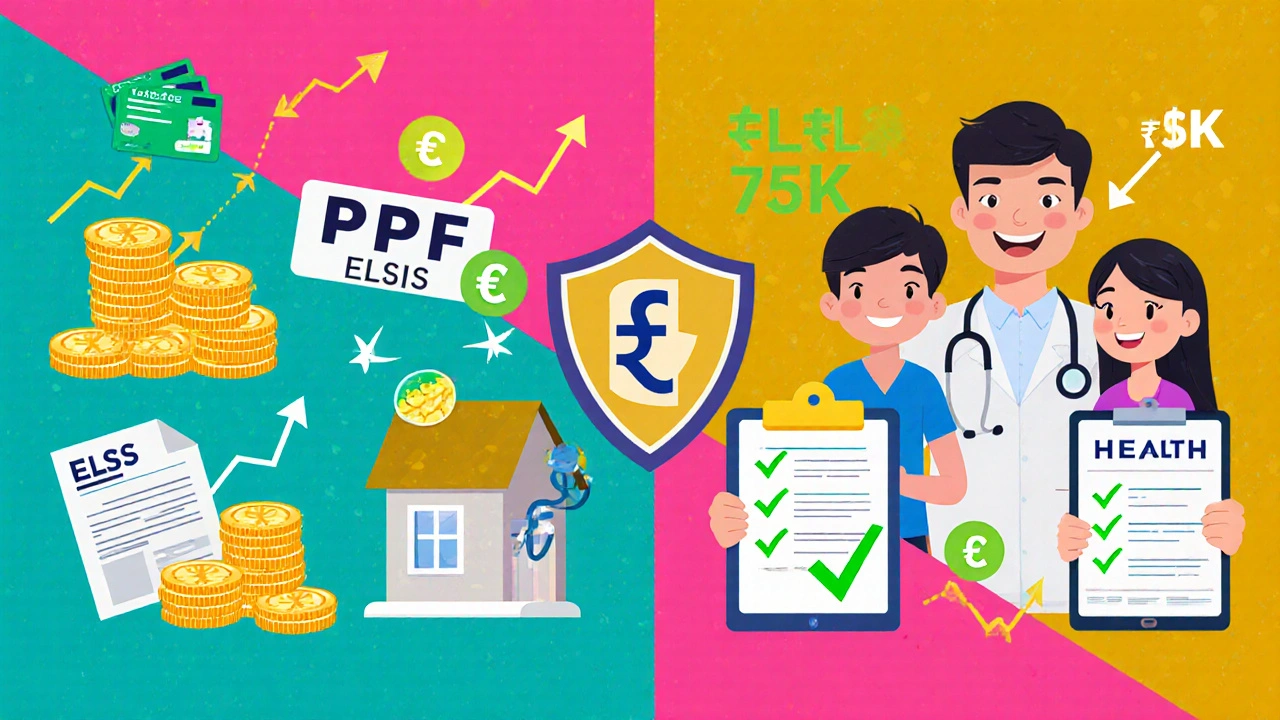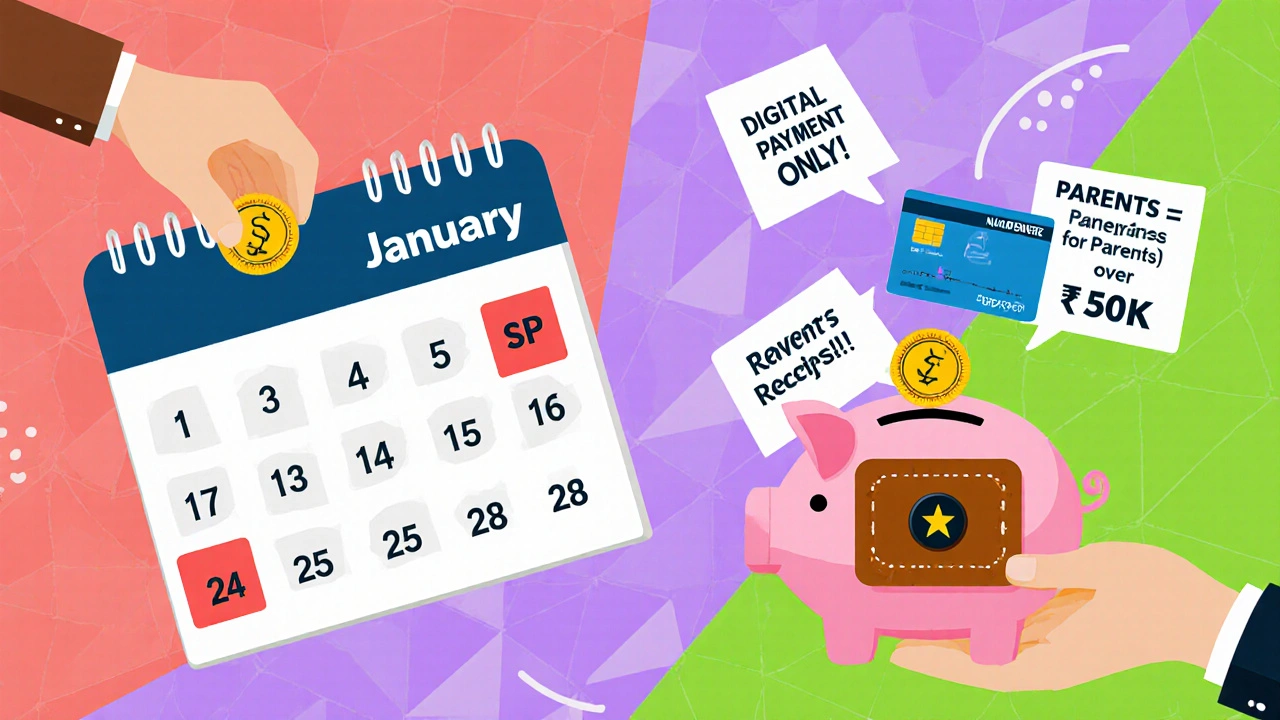Section 80C vs 80D in India: Know the Difference Between Investment and Health Insurance Deductions
 Nov, 8 2025
Nov, 8 2025
Every year, millions of Indian taxpayers miss out on thousands of rupees in tax savings-not because they don’t earn enough, but because they don’t know how to use Section 80C and Section 80D properly. These two sections of the Income Tax Act aren’t just numbers on a form. They’re powerful tools that can cut your tax bill by up to ₹1.5 lakh in a single year. But here’s the catch: mixing them up can cost you. Section 80C is about investment. Section 80D is about health insurance. Confusing the two means you might invest in the wrong thing-or worse, skip a deduction you’re already eligible for.
What is Section 80C?
Section 80C lets you reduce your taxable income by up to ₹1.5 lakh per financial year by investing in approved instruments. It’s not just about saving tax-it’s about building wealth while you save. The government encourages you to lock in money for long-term goals like retirement, education, or home ownership. And the best part? You can split that ₹1.5 lakh across multiple options.
Common 80C investments include:
- Public Provident Fund (PPF)
- Employee Provident Fund (EPF)
- Life insurance premiums (for yourself, spouse, or children)
- Equity-Linked Savings Scheme (ELSS) mutual funds
- Five-year tax-saving fixed deposits
- Principal repayment on home loans
- National Savings Certificate (NSC)
- Tuition fees for up to two children
Each of these has different lock-in periods, returns, and risk levels. For example, ELSS funds have the shortest lock-in-just three years-and historically deliver 12-15% annual returns. PPF, on the other hand, offers around 7.1% (as of 2025) but is completely risk-free and tax-free at maturity. The key is to match your investment to your goal. Need growth? Go for ELSS. Want safety? PPF or NSC works better.
What is Section 80D?
Section 80D is your shield against rising medical bills. It gives you a tax deduction for paying health insurance premiums-for yourself, your family, and even your parents. Unlike 80C, this isn’t about building wealth. It’s about protecting your family’s health while lowering your taxable income.
Here’s how much you can claim under 80D in 2025:
- Up to ₹25,000 for health insurance for yourself, spouse, and children
- Additional ₹25,000 if you cover your parents (whether they’re dependent or not)
- If your parents are over 60, you can claim up to ₹50,000 for their insurance
- Up to ₹5,000 for preventive health check-ups (this is part of the ₹25,000 or ₹50,000 limit)
So if you’re under 60 and cover yourself and your parents (who are 65), you can claim ₹25,000 (for you) + ₹50,000 (for parents) = ₹75,000 in deductions. That’s a direct reduction in your taxable income. No complex calculations. Just pay the premium, keep the receipt, and claim it.
Key Differences Between Section 80C and Section 80D
Here’s the simple breakdown no one tells you:
| Feature | Section 80C | Section 80D |
|---|---|---|
| Primary Purpose | Long-term savings and investment | Health protection through insurance |
| Max Deduction | ₹1,50,000 per year | Up to ₹75,000 (if parents are senior citizens) |
| Eligible Expenses | Investments: PPF, ELSS, EPF, life insurance, home loan principal | Health insurance premiums and preventive check-ups |
| Lock-in Period | Varies: 3 years (ELSS) to 15 years (PPF) | None-premiums paid annually, coverage renewed yearly |
| Return on Investment | Yes-grows over time, tax-free at maturity (except EPF withdrawals before 5 years) | No-only financial protection. No payout unless you claim medical expenses |
| Who Can Be Covered | Self, spouse, children | Self, spouse, children, parents (even if not dependent) |
| Can You Claim Both? | Yes-separately and simultaneously | Yes-total deductions can reach ₹2.25 lakh |
The biggest mistake people make? Thinking life insurance under 80C is the same as health insurance under 80D. They’re not. Life insurance gives a payout when you die. Health insurance pays when you get sick. One builds wealth. The other prevents financial ruin from medical bills.

How to Maximize Both Deductions Together
You can claim both Section 80C and Section 80D in the same year. In fact, you should. Here’s a realistic example:
Let’s say you’re 32, earn ₹12 lakh a year, and have a family of four. You:
- Invest ₹1.5 lakh in ELSS and PPF (full 80C limit)
- Pay ₹20,000 for your family’s health insurance
- Pay ₹40,000 for your parents’ insurance (they’re 67)
- Spent ₹3,000 on preventive health check-ups
Your total deduction: ₹1.5 lakh (80C) + ₹63,000 (80D) = ₹2.13 lakh.
That means your taxable income drops from ₹12 lakh to ₹9.87 lakh. At the 20% tax slab, you save ₹42,600 in taxes. That’s more than most people make in a month.
Pro tip: Don’t wait until March to plan. Set up automatic payments for your ELSS SIPs and health insurance renewals. That way, you’re always on track-no last-minute panic.
Common Mistakes to Avoid
Even experienced taxpayers mess this up. Here are the top errors:
- Claiming life insurance premium under 80D-it doesn’t count. Only health insurance qualifies for 80D.
- Forgetting parents-many people only cover themselves and miss the extra ₹25,000-₹50,000 for parents.
- Not keeping receipts-insurance policies and investment proofs must be retained for at least six years.
- Using the wrong account-premiums paid via cash (over ₹2,000) are not eligible. Always pay by cheque, UPI, or net banking.
- Thinking 80C is only for mutual funds-home loan principal repayment and tuition fees also qualify. Don’t ignore those.
Also, don’t assume your employer’s group health plan counts. It doesn’t. Only premiums you personally pay qualify under 80D. If your company pays for your insurance, you can’t claim it.
What About Senior Citizens?
If you’re over 60, Section 80D gets even better. You can claim up to ₹50,000 for your own health insurance. And if you’re buying it for your parents (who are also over 60), you get another ₹50,000. That’s ₹1 lakh just for health coverage.
But here’s the twist: seniors often skip insurance because they think they’re too old. That’s exactly when they need it most. Medical costs rise sharply after 60. A single hospitalization can cost ₹5-10 lakh. A ₹50,000 deduction doesn’t just save tax-it saves your savings.

What’s Not Covered?
Not everything counts. Here’s what you can’t claim:
- Medical treatment expenses (only premiums and check-ups qualify)
- Medicines bought over the counter
- Alternative therapies like Ayurveda or homeopathy unless covered under a recognized health policy
- Health insurance for siblings or in-laws
- Investments in gold ETFs or real estate under 80C
- Donations to charities
Stick to the official list. If it’s not in the Income Tax Act’s schedule, it won’t be accepted.
When to File and What Documents You Need
You don’t need to submit documents when filing your return-but you must keep them ready. The tax department can ask for proof anytime in the next six years.
For Section 80C:
- PPF passbook or statement
- ELSS mutual fund statements
- EPF contribution slip
- Life insurance premium receipt
- Home loan principal repayment certificate from bank
For Section 80D:
- Health insurance premium receipt (must show policy number and payment mode)
- Preventive health check-up bill (must be from a recognized clinic)
Always pay premiums digitally. Cash payments over ₹2,000 are disallowed under Section 80D. Use UPI, NEFT, or net banking. Keep screenshots or bank statements as backup.
Final Tip: Don’t Wait Until March
Most people start thinking about tax savings in February. By then, the best ELSS funds are full. Premiums for health insurance go up after your birthday. You end up paying more and getting less.
Plan ahead. In January, set up your SIPs for ELSS. Renew your health insurance. Review your parents’ coverage. Make a checklist. Do it once. Then forget about it until next year.
Section 80C and 80D aren’t complicated. They’re just overlooked. Get them right, and you’re not just saving tax-you’re securing your family’s future.
Can I claim both Section 80C and Section 80D in the same year?
Yes, you can claim both deductions in the same financial year. Section 80C covers investments up to ₹1.5 lakh, and Section 80D covers health insurance premiums up to ₹75,000 (if your parents are senior citizens). Together, you can reduce your taxable income by up to ₹2.25 lakh annually.
Is life insurance covered under Section 80D?
No, life insurance premiums are not eligible under Section 80D. They qualify only under Section 80C. Section 80D is strictly for health insurance premiums and preventive health check-ups. Don’t confuse the two-life insurance protects your family after your death, while health insurance covers medical costs while you’re alive.
Can I claim health insurance for my parents if they’re not dependent on me?
Yes, you can claim a deduction under Section 80D for health insurance premiums paid for your parents-even if they are financially independent. Dependency status doesn’t matter. As long as you pay the premium, you’re eligible for the deduction.
What happens if I pay my health insurance premium in cash?
If you pay your health insurance premium in cash and the amount exceeds ₹2,000, you cannot claim the deduction under Section 80D. The law requires payments to be made through banking channels-like NEFT, UPI, cheque, or net banking. Always use digital payments to stay compliant.
Can I claim preventive health check-up expenses under Section 80C?
No, preventive health check-ups are only eligible under Section 80D, up to ₹5,000 per year. Section 80C covers investments like PPF, ELSS, and life insurance premiums, not medical expenses. Don’t try to claim check-ups under 80C-it won’t be accepted.
Do I need to submit documents to the income tax department while filing?
No, you don’t need to submit documents when filing your income tax return. But you must keep proof-like premium receipts, investment statements, and bank transaction records-for at least six years. The tax department can ask for them during an assessment or audit.
